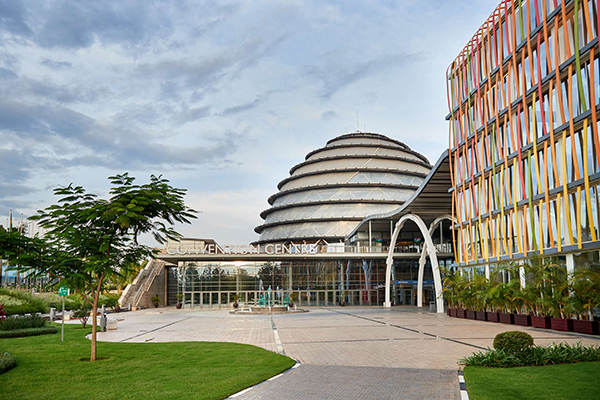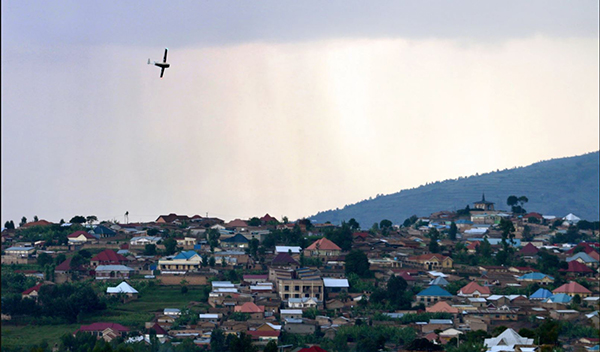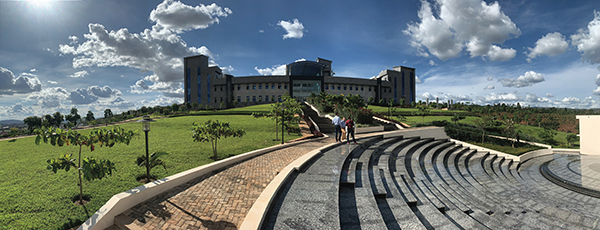Certain countries — like Taiwan, South Korea, or Singapore — have famously risen out of poverty thanks to capitalism. These countries are now world class “first world” nations with developed market economies.
Soon, Rwanda will be joining their ranks. The country is one of the most striking examples of a relatively poor, landlocked country rising out of tragedy into success.
Twenty years ago, few would have predicted that Rwanda would become a success story. The country had gone through an incomprehensibly horrible genocide, which saw its most capable and educated citizens brutally slaughtered. The country had hundreds of thousands of refugees, and was mired in absolute poverty. It was landlocked, surrounded by volatile and unreliable neighbors such as the Democratic Republic of Congo (DRC) and enemies like Uganda.
However, Rwanda has overcome its circumstances. Today, the country is considered one of the least corrupt and most stable countries in Africa — it ranks as the 49th least corrupt of 180 countries analyzed by Transparency International in the 2020 edition of its annual Corruption Perceptions Index. And Rwanda ranks higher than countries such as Switzerland and Japan on the most recently published Ease of Doing Business report from the World Bank. Rwanda has experienced explosive GDP growth, emulating patterns previously seen only in Asia’s tiger economies.
The country now stands as a bright example of what a country can achieve in similar circumstances. It is a reminder that, with free market policies and a stable government, countries can thrive even under the most dire crises.
Rwanda’s Genocide
In early April 1994, a civil war between the country’s two main ethnic groups descended into a genocide of between 500,000 and 1 million people, mostly ethnic Tutsi. Seventy percent of the Tutsi population was murdered. Up to half a million women and children were raped, sexually mutilated, or murdered. Many moderate Hutus were also killed.
The genocide came to an end in 1994 when the Tutsis from neighboring Uganda joined forces with their peers in Rwanda. A militia group known as the Rwandan Patriotic Front made its way from the north of the country, and swept its way south towards Kigali, putting an end to the conflict.
The country’s already weak economy crashed in the wake of the genocide. From 1990 to 1994, Rwanda’s GDP fell from approximately US$2.5 billion to a low of $750 million USD, according to the World Bank. As a result of the war and genocide, 78% of the population now lived below the poverty line. The average Rwandan’s life expectancy had been shortened to approximately 28 years.
As the Rwandan Patriotic Front consolidated power throughout the rest of the 1990s, they were forced to rebuild the country’s institutions and infrastructure from scratch.
Reconstruction, Recuperation & Vision
The years after the genocide from 1994 until 2000 were harsh and chaotic for Rwanda. Roughly 10% of the population had died as a result of the genocide. At least 2 million refugees had been displaced. The economy had been destroyed, and social trust had evaporated.
The country existed in a state of limbo. Uncertainty about whether or not the Rwandan Patriotic Front would engage in revenge killings lingered. Furthermore, refugees had moved from Rwanda into neighboring Zaire, triggering another conflict there. A second, smaller genocide followed. Tutsi extremists would massacre 235,000 Hutu refugees who had crossed the border.
The chaos would finally be brought to an end when Paul Kagame, the former leader of the Rwandan Patriotic Front, ran for president in 2000 and won. In many ways, the election of Paul Kagame can be seen as the turning point for Rwanda. His attention to detail would reverse corruption, and his appreciation for markets would make Rwanda attractive for business. Under his leadership, Rwanda would not only rebuild what it had lost but exceed all of its past achievements.
In order to accomplish the arduous task of rebuilding Rwanda, the Kagame-led government drafted a list of long-term goals for the country in the early 2000s. The most important would be for Rwanda to achieve middle income status by 2020. At current growth rates, this goal will be achieved right on schedule by 2021 or 2022.
Officially starting in 2000, the government structured its policy around a plan called “Vision 2020.” This plan became the first in a series of national growth strategies, including Vision 2050 and the National Strategy for Transformation. The goal of each of these plans is to implement the best practices in governance from around the world.
To achieve this vision, the government improved and simplified the country’s laws and regulations. There was a special focus on the development of infrastructure, the ease of doing business, the improvement of education and the reduction of corruption.
Long-term government planning rarely works. Rwanda is one of the few examples of a government master plan which has successfully paid off. As of 2019, the country has experienced a significant transformation in terms of economic development. For example, GDP per capita has grown at a rate of 5% per year since 2006, and continues to grow at a healthy rate (the entire economy grew by 8.6% in 2018).
Anecdotal indicators such as the growth and diversification of the industrial and service sectors, infrastructure development and urbanization, as well as access to healthcare and financial institutions, have also improved.
Ease of Doing Business
According to the World Bank’s Ease of Doing Business indicators, Rwanda has quickly jumped to No. 29 in the world, with Mauritius being the only African country with a higher ranking. As a comparison, Rwanda’s Ease of Doing Business score surpasses that of highly developed countries such as Japan and Switzerland.
Paul Kagame, Rwanda’s longtime president, has gone on record to say that he wishes Rwanda to become the “Singapore of Africa,” a stable gateway of trade for the entire continent. The Heritage Foundation’s Economic Freedom Index ranks Rwanda as No. 32 worldwide, ahead of “first world” countries like France, Belgium, Italy, and Spain.

A Radisson Blu hotel sits next to the convention center in Kigali.
Photo courtesy of Radisson
Rwanda scores especially high in terms of protection of property rights, government spending, healthcare, labor freedom, and jurisdictional effectiveness. For example, property rights are well protected and clearly enforced. In 2018, the government implemented an online property registry which made it easier to define and enforce property rights.
The Heritage Foundation reports that the top personal income and corporate tax rates are 30%. Other taxes include value-added and property transfer taxes. The overall tax burden equals 15% of total domestic income.
Still, it is important to note that serious barriers continue to impede Rwanda’s construction of a knowledge-based middle income economy. These include significant poverty, urban infrastructure/transportation restrictions, a relatively small private sector, an over-reliance on agriculture, and geographic trade difficulties, among others. Furthermore, the courts suffer from backlogs and lack of funding. There also are issues with protectionist policies in the agriculture sector.
How the Rwanda Development Board Facilitates Business
The consolidation of government agencies into the Rwanda Development Board (RDB) has played a key role in the country’s ability to develop its economy. As Rwanda carried out its Vision 2020 reforms, it decided to consolidate the various government offices that were focused on economic development under one authority, the RDB, whose core funcation is to operate as a “one-stop shop” for all of Rwanda’s business procedures.
This consolidation has been critical in Rwanda’s transformation into a free market economy. The RDB was installed in 2009 administer the country’s business regulations, foreign investments, tourism promotion, environmental conservation, and overall development planning. Previously, these functions had been carried out by a wide variety of miscellaneous government agencies. The consolidation helped improve efficiency while reducing conflicts and contradictions.
Streamlining regulatory frameworks and administrative services via the RDB forms the core of Rwanda’s efforts to attract foreign investment and grow its domestic private sector.
Additionally, the government has constructed several special economic zones (SEZs) across the country. SEZs are business parks which provide their tenants with exemptions from various government regulations as well as high quality infrastructure and utilities. If you want to register a company, obtain a visa or work permit, or apply for land within an SEZ, you must go through the RDB.
SEZ Growth Strategy
The history of SEZs as a development tool in Africa is often a cautionary tale. Most SEZs elsewhere in Africa devolve into centers of corruption and waste. There are rare success stories, such as Mauritius’s export processing zones or Morocco’s Tanger Med Free Zone.
It is likely that Rwanda will soon be another success story.
Rwanda’s SEZ program began with the drafting of the 2011 SEZ law, which provided a framework for the creation of several zones within the country. The most notable is the Kigali Special Economic Zone (KSEZ), located just northeast of the Kigali International Airport. Construction began in mid-2012 and the zone was finished in the summer of 2013. The zone is operated as a public-private partnership in cooperation with Prime Economic Zones, a Rwandan firm designated as the operator of KSEZ.
As it stands, the first phase of the KSEZ covers 98 hectares (242 acres) and is occupied by 97 different firms who employ over 12,000 employees. Numerous interesting projects, such as Carnegie Mellon’s first Africa University campus, are located in the KSEZ.
The key value provided to tenants within the zone are a customs free regime, tax incentives, and easy access to the RDB. In addition, the zone boasts stable hard infrastructure: quality roads, electricity, fiber-optic internet, clean water, sewage treatment and fire services.
Prime Economic Zones, the company that runs the KSEZ, treats its tenants the way that any other commercial real estate lender would. They maintain the security, infrastructure and utility aspects of the zone. They work closely with the Rwanda Development Board to optimize the zone by gathering data and reporting complaints, with the long-term goal of optimizing government regulations in order to maximize efficiency.
SEZs in Rwanda are becoming ever more competitive. The SEZ law was revised in 2018 in order to streamline regulations and generate more private-sector investments. This new law changed the leasing system so that foreigners can obtain 99-year leases. Additionally, tax advantages were reduced, with the RDB refocusing its efforts on the streamlining of permits. There is an improved one-stop-shop approach to all compliance matters within the zone. Special tax consideration is offered, however, to developers and tenants that have been designated as instrumental to Rwanda’s 2020 and 2024 growth plans.
With improving Rwanda’s ease of doing business as its core goal, the KSEZ has proved to be a competitive model, and is currently expanding to include another 178 hectares (440 acres).
Additionally, new SEZs are being planned throughout Rwanda, with the aim of bringing the same level of infrastructure development and private-sector growth that the KSEZ has experienced to other locations in the country.
Laboratory for Innovation
When most Westerners imagine African development, they likely think of simple industries such as textiles or food processing. While Rwanda has attracted a lot of light manufacturing, it is also quickly becoming Africa’s tech capital. The most recent example of this is the opening of a new Mara Phones manufacturing plant in Kigali.
On October 7, 2019, the very first smartphone manufacturing plant on the African continent began operations. Run by a subsidiary of Mara Group, it sources all of its materials from around Africa, and manufactures the phones from the motherboards all the way to the packaging.
Many might have expected Mara Group to build its factory in a large African city such as Johannesburg, Lagos or Nairobi. Instead, Africa’s first smartphone plant was built in Rwanda, within the KSEZ.
In Africa’s larger and more established cities, tech companies like Google and Oracle have already crowded the market. By choosing to locate within the Kigali SEZ, Mara Group was able to secure support from the Rwandan government and a favorable jurisdiction.
A similar success story can be found the choice of international auto giant Volkswagen to open up a production facility inside the KSEZ. In early 2018, Volkswagen expanded into Rwanda with a $20 million production plant. The facility has the capacity to produce 5,000 vehicles per year, and employs 1,000 people.
The plant operator, Volkswagen Mobility Solutions Rwanda, is a subsidiary of Volkswagen Group South Africa. The “Mobility Solutions” designation is a clue to VW’s plans to use Rwanda as a laboratory for its newest technologies, rather than for just the production and sale of vehicles. The most compelling example of this approach is VW Move, a ridesharing smartphone application launched by VW Rwanda that currently has over 20,000 downloads within the country. In effect, VW is attaching itself to Rwanda’s growing reputation as a platform for innovation by beta testing its app in Kigali.Another example of Rwanda’s focus on innovation is the Kigali Innovation City, a 70-hectare (173-acre) project to kickstart the region’s competitiveness in the digital services sector. Situated as an attachment to the KSEZ, Kigali Innovation City is designed as a hub of educational institutions meant to facilitate the transfer of knowledge and skills to Rwandan students and professionals.
As a cornerstone of this project, Carnegie Mellon University opened its newest African campus there in 2018. It has a capacity of 300 students, who can choose a master’s studies program in either information technology or electrical and computer engineering.
Just as Mara Phones and Volkswagen are attempting to use Rwanda as a foundation for future business in Africhotela, Carnegie Mellon aims to benefit from the Rwandan government’s overt commitment to supporting cutting-edge institutions. Eventually, Carnegie Mellon plans to use Rwanda as its base of operations for doing business elsewhere in the African continent.
The total cost of Kigali Innovation City is projected to be approximately $2 billion. A total of $400 million has already been pledged by infrastructure investment group Africa50. Kigali Innovation City fits neatly into the government’s Vision 2020/2050 programs, including the National Strategy for Transformation. In the future, the KSEZ will also house the Digital Innovation Precinct, a non-academic tech hub focusing on digital technology, ICT and similar service-oriented areas.
From Bloodshed to Blood Delivery
A final example of Rwanda’s burgeoning culture of private innovation is its use of drones to deliver blood and vital medical supplies to hospitals.
Rwanda’s roads, especially in the countryside, are of low quality. During the rainy season, they become muddy and travel becomes difficult. This poses significant challenges to hospitals, which need critical medical supplies with a short shelf life, such as blood.
Rwanda solved this problem by hiring Zipline, a Californian drone delivery service. If a patient in a rural hospital needs blood, the doctor in the hospital makes a call to one of Zipline’s two blood banks in the country. The staff at the blood bank will then load a drone with the appropriate blood type, and launch it using a custom-built slingshot system. Within 60 minutes, the drone will arrive at the hospital, drop the supplies via parachute, then return to the blood bank.

Zipline, whose drone is shown here flying over Rwanda’s second-largest city of Muhanga, first launched blood deliveries in Rwanda in October 2016, and has since built the first and only automated, on-demand delivery service to operate at multinational scale.
Photo courtesy of Zipline
Rwanda was the first country to use drone delivery services for medical supplies. Every hospital in the country is covered by the program, and it has already saved hundreds of lives. The success of the program has led to other countries, such as Ghana, also hiring Zipline to replicate this program. As of 2019, Zipline is valued at over $1.2 billion, and is capable of delivering more than 170 different vaccines, blood products and medications to nearly 22 million people.
In a symbolic sense, the country has moved from the horror of a genocide that spilled blood to a pioneering innovation that ships blood to save lives.
Bouncing back from the anguish and turmoil of civil war and genocide, Rwanda has refashioned itself into a low-middle income country in just over 20 years. It has followed a path only seen in the world’s most dynamic economies Taiwan, China, Singapore, South Korea, Chile, or the United Arab Emirates.
By implementing key reforms to facilitate ease of doing business and focusing its budget on providing high-quality infrastructure, Rwanda has shown the world that Africa can have its own global leader.
Many analysts now call Rwanda “the Singapore of Africa.” Day by day, that name grows in relevance.
Thibault Serlet is co-founder and chief researcher of Adrianople Group, a research and advisory firm focused on educating the world about Special Economic Zones (SEZs). Preston Martin is co-founder and CEO. For more information, visit adrianoplegroup.com.
